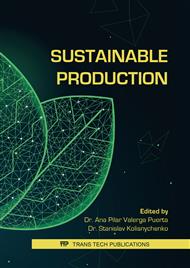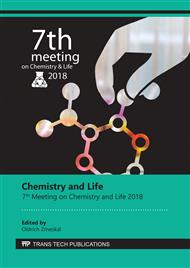[1]
K. Dumorne, D,C, Córdova, M. Astorga-Elo, P. Renganathan. Extremozymes: A Potential Source for Industrial Applications. J. Microbiol. Biotechnol. 27 (2017) 649-659.
DOI: 10.4014/jmb.1611.11006
Google Scholar
[2]
A. Krüger, C. Schäfers, C. Schröder and G. Antranikian. Towards a sustainable biobased industry – Highlighting the impact of extremophiles. New Biotechnol 40 (2018) 144 – 153.
DOI: 10.1016/j.nbt.2017.05.002
Google Scholar
[3]
G.-Q. Chen, Z.-R. Jiang. Next generation industrial biotechnology based on extremophilic bacteria. Curr. Opin. Biotechnol. 50 (2018) 94-100.
DOI: 10.1016/j.copbio.2017.11.016
Google Scholar
[4]
S. Obruca, P. Sedlacek, M. Koller, D. Kucera, I. Pernicova. Involvement of polyhydroxyalkanoates in stress resistance of microbial cells: Biotechnological consequences and applications. Biotechnol. Adv. 36 (2018) 856 – 870.
DOI: 10.1016/j.biotechadv.2017.12.006
Google Scholar
[5]
S. Obruca, P. Sedlacek, F. Mravec, V. Krzyzanek, J. Nebesarova, O. Samek, D. Kucera, P. Benesova, K. Hrubanova, M. Milerova, I. Marova. The presence of PHB granules in cytoplasm protects non-halophilic bacterial cells against the harmful impact of hypertonic environments. New Biotechnol. 39 (2017) 68-80.
DOI: 10.1016/j.nbt.2017.07.008
Google Scholar
[6]
M. Koller. Recycling of waste streams of the biotechnological poly(hydroxyalkanoate) production by Haloferax mediterranei on whey. Int. J. Polym. Sci (2015) Article ID 370164.
DOI: 10.1155/2015/370164
Google Scholar
[7]
Y.-K. leong, P. L. Show, C. W. Ooi, T.C. Ling, J. C-W. Lan. Current trends in polyhydroxyalkanoates (PHAs) biosynthesis: Insights from the recombinant Escherichia coli. J. Biotechnol. 180 (2014) 52 – 65.
DOI: 10.1016/j.jbiotec.2014.03.020
Google Scholar
[8]
M. Koller, E. Chiellini, G. Braunegg. Study on the production and re-use of poly(3-hydroxybutyrate-co-3-hydroxyvalerate) and extracellular polysaccharide by the archaeon Haloferax mediterranei strain DSM 1411. Chem. Biochem. Eng. Q. 29 (2015) 87-98.
DOI: 10.15255/cabeq.2014.2058
Google Scholar
[9]
H. Guzmán, D. Van-Thuoc, J. Martín, R. Hatti-Kaul, J. Quillaguamán. A process for the production of ectoine and poly(3-hydroxybutyrate) by Halomonas boliviensis. Appl. Microbiol. Biotechnol. 84 (2009) 1069 – 1077.
DOI: 10.1007/s00253-009-2036-2
Google Scholar
[10]
S. Obruca, O. Snajdar, Z. Svoboda, I. Marova. Application of random mutagenesis to enhance the production of polyhydroxyalkanoates by Cupriavidus necator H16 on waste frying oil World J. Microbiol. Biotechnol. 29 (2013) 2417-2428.
DOI: 10.1007/s11274-013-1410-5
Google Scholar
[11]
D. Kucera, I. Pernicová, A. Kovalcik, M. Koller, L. Mullerova, P. Sedlacek, F. Mravec, J. Nebesarova, M. Kalina, I. Marova,V. Krzyzanek, S. Obruca. Characterization of the promising poly(3-hydroxybutyrate) producing halophilic bacterium Halomonas halophila. Bioresour. Technol. 256 (2018) 552-556.
DOI: 10.1016/j.biortech.2018.02.062
Google Scholar
[12]
M. T. García, E. Mellado, J. C. Ostos, A. Ventosa. Halomonas organivorans sp. nov., a moderate halophile able to degrade aromatic compounds. Int. J. Syst. Evol. Microbiol. 54 (2004) 1723-1728.
DOI: 10.1099/ijs.0.63114-0
Google Scholar
[13]
A. Kovalcik, S. Obruca, I. Marova. Valorization of spent coffee grounds: A review. Food Bioprod. Process.,110 (2018) 104-119.
DOI: 10.1016/j.fbp.2018.05.002
Google Scholar
[14]
A. Rodríguez-Contreras, M. Koller, G. Braunegg, M.S. Marqués-Calvo. Poly[(R)-3-hydroxybutyrate] production under different salinity conditions by a novel Bacillus megaterium strain. New Biotechnol. 33 (2016) 73-77.
DOI: 10.1016/j.nbt.2015.08.006
Google Scholar



